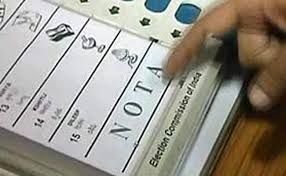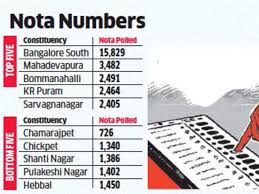Everything To Know About Nota
Apr 07, 2019 • 206 views
1. What is the meaning of NOTA?
‘NOTA’ means ‘none of the above’. It is the right given to voters to reject all the candidates contesting the elections. It was regarded as a fundamental right by the Supreme Court on 27th September, 2013. The EVMs have a button for ‘NOTA’ at the end of the candidate’s list.

2. Was there any such provision before NOTA?
Yes, before NOTA came into existence, voters who wanted to reject all the candidates contesting the elections were required to enter their names in a separate register and a different paper ballot was used to cast their votes.
Under Section 49 (O), a voter can cast vote against the candidates by filling their electoral serial number in Form 17A which would then be approved by the presiding officer. Once that is done, the signature of the voter is taken. This provision has been ruled out by Supreme Court once NOTA came into existence. It is primarily done to maintain the privacy of the voters opting for NOTA.
3. What impact do NOTA have in general elections?
By casting vote for NOTA, the results of the elections do not change. The candidate who earns maximum votes out of the remaining votes still wins the election. But the purpose of NOTA is different. It is not aimed to change the result of the election. The purpose of NOTA is to give a message to the political parties that not even a single candidate contesting the election is worthy to be selected. It also sends across a message to the political parties to project good and worthy candidates.
4. What has been the trend of NOTA since its inception?
NOTA was first introduced in 2013 Assembly election in – Chhattisgarh, Mizoram, Rajasthan, Madhya Pradesh, and Delhi. 1.85% of the total votes polled were in the NOTA category. The percentage significantly reduced to 0.95% in 2014 Assembly elections which was held in 8 states. It increased to 1.1% of the total votes in 2014 Lok Sabha polls which further increased to 2.02% in 2015 Assembly elections held in Delhi and Bihar. NOTA polling figures are still very small. The 2019 Lok Sabha election will be a driving force on how the NOTA will move.

2018 Assembly elections
5. Is NOTA a 100% efficient system?
This is a very conflicting argument. So we should look at both sides of the coin. We have already discussed about the positive impacts of NOTA in question 3. So let’s talk about the other side of the coin.
According to me, though NOTA gives the candidate the right to reject all the candidates contesting the election but it is not actually a right to reject because even if 50% of the voters vote for NOTA, the votes of remaining 50% of the voters will be considered to choose the candidate. So, the candidate will be selected whether we vote for NOTA or we do not vote at all. Thus, it is equivalent to not voting at all.
But as mentioned in earlier point that purpose of NOTA is different. But there is a loophole in that system. The number of votes from NOTA will ensure that certain percentage of voters is unwilling to choose from any of the candidates contesting the polls. But it does not specify the reason for the unwillingness among the voters.
If the reason is unknown, the whole purpose of NOTA is destroyed and thus the same trend will continue. We will continue to have the same candidates contesting the polls, the percentage of NOTA will keep increasing, and the political parties will keep winning the elections based on the remaining voters.
Thus, concern should be raised by each and every voter as to how to overcome these shortfalls in order to make NOTA an efficient system of India.
